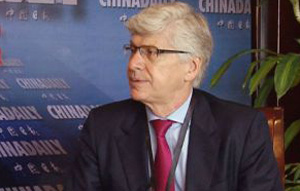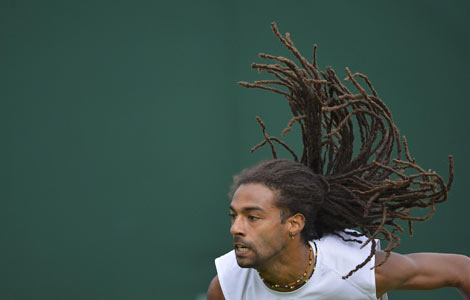Getting the point of Chinese medicine
Updated: 2013-06-25 06:58
By Peng Yining (China Daily)
|
|||||||||||
|
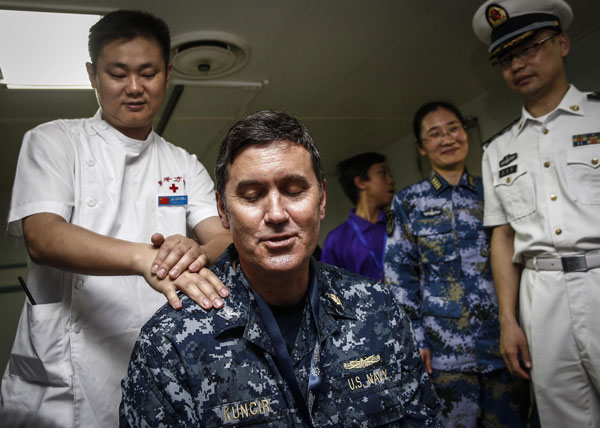 |
|
Erik Kuncir, a medical expert with the US navy, enjoys massage treatment by Chinese therapist Gu Wei on June 18 onboard Chinese hospital ship Peace Ark, which visited Brunei for a drill involving a number of countries including China and the United States. ZHANG HAO / FOR CHINA DAILY |
Editor's note: On June 10, the Peace Ark embarked on a 118-day voyage to provide medical assistance to residents of neighboring countries and take part in joint operations and exercises with fellow members of ASEAN. This is the second report (First report) by China Daily's Peng Yining, who is aboard the vessel.
|
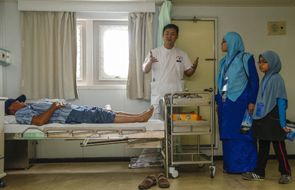 Gu Wei, one of the ship’s Chinese medicine professionals, explains the theory behind cupping therapy. ZHANG HAO / FOR CHINA DAILY
Cooperation is the way forward As part of the joint humanitarian drill held by the Association of Southeast Asian Nations Defense Ministers' Meeting Plus, medical experts from China and the United States held a joint discussion about the provision of international humanitarian services. After a tour of the ship, US Navy Captain Lynn Wheeler said Peace Ark is a world-class military hospital ship. Wheeler will serve as commander of the USS Mercy, one of the largest hospital ships in the world, in the next month. "Mercy and Peace Ark are basically doing the same thing," she said. "Humanitarian services are universal." Led by Wheeler, two medical professionals from the US military gave presentations alongside their Chinese peers. Du Xin, a Chinese doctor, delivered a lecture on the lessons the PLA General Hospital learned during the rescue mission after the 2008 earthquake in Sichuan province, Erik Kuncir, a US navy medical expert, said China and the US can learn a lot from each other. "I was impressed that the Chinese doctors conducted an amputation on an earthquake survivor to save her life. We have similar cases in the army in Iraq and Afghanistan," he said. "Peace Ark is a beautiful ship," said Michael Termini, another US navy expert. "And more importantly, it's a lifesaving ship." Termini gave a presentation on the humanitarian services provided by the US in the Pacific region. "I am very impressed by the Peace Ark, the crew and facilities. I am very happy to see them coming to Brunei. China and many other states, including the US, are participating in providing humanitarian services, and I hope cooperation will increase in the future," said Daniel L. Shields, the US ambassador to Brunei, after he visited the Peace Ark. "The US has been providing humanitarian services worldwide for a long time and has the best hospital ships, equipment and technology in the world," said Guan Bailin, deputy commander of the 2013 Peace Ark mission. "We have a lot to learn from them and we are also looking forward to cooperating with them in the future." - Peng Yining and Ju Zhenhua |
With a lowered chin, the 12-year-old Bruneian girl watched as a Chinese doctor slid one-third of a 3-centimeter stainless steel needle into her mother's right ankle.
"Doesn't it hurt, Mom?" asked the girl. Noraini Nora just shook her head and smiled.
Nora had injured her ankle in a fall a couple of days before. When she heard on the local news that a Chinese hospital ship had anchored in Brunei and was providing free medical treatment, including traditional Chinese therapies, she came along immediately.
"I've heard how amazing Chinese medicine is for a long time," she said. "And now I finally have the chance to try it."
Brunei was the first stop on the 2013 Peace Ark mission. The hospital ship will visit eight countries across Asia to provide free medical services during the voyage, which lasts from June 10 to Oct 6. In addition to world-class Western medical equipment and staff, the ship's crew includes three specialists in traditional Chinese medicine.
"The Peace Ark mission is not only providing free medical services, but also providing a great opportunity for people worldwide to learn about China and Chinese culture," said Guan Bailin, deputy commander of the mission and head of the Chinese Navy's health department. "Chinese medicine can act as a bridge to connect people from different backgrounds."
After 10 minutes of treatment, Nora said the pain and swelling in her ankle had eased. "I felt a little jab when the doctor first put the needle into my ankle, but the treatment really works," she said.
Gu Wei, one of the ship's Chinese medicine professionals, said acupuncture relieves pain quickly, but the patient will need long-term treatment for the injury to heal completely. The Peace Ark can provide a variety of TCM treatments, including acupuncture, massage and cupping.
During the ship's five days at the port of Seri Begawan, it was visited by 1,300 residents and more than 100 of them received free health checks and treatment.
Tongue tied
The Chinese medicine consulting room, on deck five of the ship, was the most popular destination for patients. People crowded around the three doctors, watching as others were treated. Gu said dozens of people arrived every day and asked to try the therapies.
Suryanti Noor, who came for treatment on her sore shoulders and neck, had undergone acupuncture on the ship a few days before and was paying a second visit for more advice about her health.
"Please, show me your tongue," requested Gu. In response, Noor laughed out loud and, embarrassed, hid her face in her hands.
"To people who have never tried Chinese medicine before, it might seem strange that the doctor takes their pulse and asks to see their tongue," said Gu. "But the color and size of the tongue are good indications of the patient's health."
To explain the process, Gu poked about 2 cm of his tongue out of his mouth. He gestured for Noor to repeat his action, but the 37-year-old and other locals watching in the room just burst into laughter.
Some of the younger patients were wary of the treatment. "I would rather swallow a pill than be stabbed with a needle," said 13-year-old Shahronney Hassam.
The confusion and wariness didn't last long, though. "Most people understood eventually," said Gu.
Ethnic Chinese
The Chinese are no strangers to Brunei; indeed, 11 percent of the population is ethnic Chinese. "There is a large Chinese community and Chinese culture is very popular here," said Huang Shunping, a 52-year-old local resident, whose grandparents moved to the country from East China's Fujian province in the 1940s to work as woodcutters.
Life was tough for the first generation of immigrants and TCM was the only hope when people fell ill. That reliance saw the skills and culture passed down from generation to generation, according to Huang.
"I have been consulting doctors of traditional medicine in the local clinics my entire life," he said. "I'm happy that the Peace Ark has brought more doctors from the Chinese mainland."
|
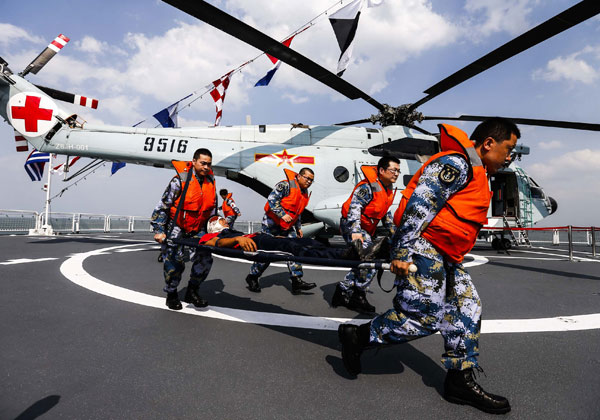 |
|
Crew members of Peace Ark conduct an emergency rescue drill. ZHANG HAO / FOR CHINA DAILY |
Today's Top News
France wants more Chinese investment
FM: China rejects US' claim on Snowden
Public interests Party's top priority
Overseas sellers upbeat on China
PBOC will act 'if necessary'
4 Chinese killed in Papua New Guinea
'Heavy losses' if China-EU solar sector talks fail
Riots in Xinjiang kill 27
Hot Topics
Lunar probe , China growth forecasts, Emission rules get tougher, China seen through 'colored lens', International board,
Editor's Picks

|

|

|
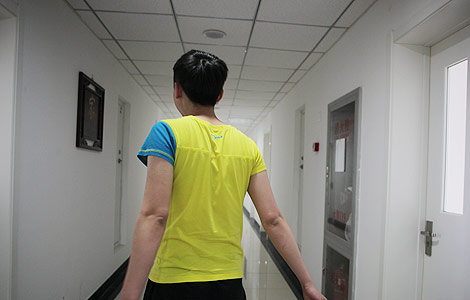
|
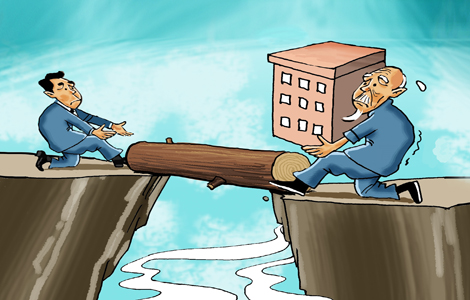
|

|
